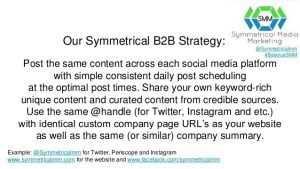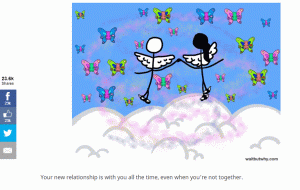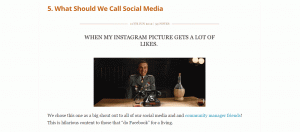Coming up with an effective content promotion strategy can be trickier than you might think. Columnist Andrea Lehr highlights three common mistakes marketers make and offers tips on how to avoid them.

Think about the last great piece of content you saw. Did you find it directly at the source, or did you find it after bouncing around among a few links? It’s likely the latter, and you found it because whoever produced it knew you would find it there.
Great content doesn’t get in front of the right audience by chance; it’s the direct result of a well-planned promotions cycle. And although developing a successful content promotion strategy may sound easy, it actually requires more work than you think — whether you’re a first-timer or not.
Before diving into your next outreach cycle, let’s take a look at three common mistakes and a few ways to avoid them.
1. Assuming outreach is a numbers game
Gone are the days of sending hundreds of emails to generate coverage — in large part because some publishers report receiving more than 100 pitches a day! It’s easy for a pitch to fall to the bottom of someone’s inbox, which is why the best outreach strategies are incredibly selective.
So what are some ways to craft a highly targeted outreach strategy?
- Understand what makes a publisher exclusive-worthy versus syndication: When you offer someone the exclusive, you’re promising that publisher that they’ll be the first to report whatever it is you’re offering them. Your content’s success relies heavily on leveraging the natural syndication network of top-tier publishers, so two things you want to look out for when pitching the exclusive are a publisher’s engagement level and their domain authority (DA). If they have a ton of engagement and a DA of 80 or more, you’ve found a great candidate for your exclusive!
- Do your research before pitching: Not understanding what a publisher covers, what a specific reporter writes about, and whether or not the outlet has already written about something similar to your content wastes everyone’s time — and implies that you don’t care. Use a publisher’s masthead as a starting point and then find out more about specific editors through their own social profiles and post archives.
- Think beyond traditional coverage: Fractl (my employer) collaborated with Moz to take a closer look at a phenomenon known as “majority illusion.” In short, the theory emphasizes that only a handful of well-connected individuals are needed to make something seem more popular than it actually is and give the impression that everyone in a specific network is talking about it. In regard to promotion, this means that a tweet from one highly connected individual can do a lot more than one low-level placement.
2. Overestimating newsworthiness
The hard truth is that your content isn’t going to be newsworthy on its own. But the good news is that it’s not that hard to persuade an editor why it is — particularly if your content carries broad interest and is truly unique.
Below are five different angles that will make your content feel more timely and fresh to a publisher:
- Consequence: In other words, does your content answer the question, “So what?” Generally, the more people affected by an event or issue, the more newsworthy it is. A great example is the Tampa Bay Times’ “Failure Factories,” a five-part series that synthesized more than five years of disastrous decisions from the Pinellas County School Board and turned them into an engaging story.
- Proximity: Localizing an extensive data set is a great way to earn a ton of coverage. Consider this campaign for Movoto that identifies the wealthiest person in each state. You’re guaranteed at least 50 placements in each state so long as your pitch feeds into regional ego bait.
- Controversy: The innate appeal of polarizing content is that it triggers an emotional response — an essential ingredient in generating massive shares. A great example is this campaign that reimagined superheroes to reflect more realistic body types. When the less-toned superheros were paired alongside their original sketches, the stark contrast between the two images offered a new way to discuss body issues — a fresh angle publishers loved.
- Magnitude: Another way to get your content trending is to emphasize how many individuals are interested. This video from Fanatics is newsjacking at its finest: Right after the Golden State Warriors took back their crown as NBA champs, the video showed minute-by-minute sales of their merchandise across the country.
- Necessity: Does your content include data that isn’t readily available to the public? It’s easy to pitch original data that is surprising, and “Hotel Hygiene Exposed” is a great example of this in action. The newsworthy angle came from the fact that the project proved that the nicest hotels are actually the dirtiest — a fact any hotel guest would love to know.
3. Forgetting to set goals and other success metrics
A comprehensive content marketing strategy should always include ways to measure success, and this is particularly true when it comes to outreach. Identifying specific goals for your content will keep your outreach cycle more targeted, and reviewing a final report of all placements will help you identify which relationships are worth nurturing and pursuing again for future content.
An easy way to set the right goals is to think about your content in terms of where it fits within the three-part sales funnel:
- Awareness: The goal of content at this level is simply to get it in front of as many eyes as possible.
- Conversion: At this level, your content should convince someone why your product or service is better than any other option.
- Nurturing: This level typically includes automated content — like email workflows — where the main goal is to keep your brand on someone’s radar whenever possible.
You’ll also want to take a look at specific metrics that will help you determine whether or not you’ve met these goals at a more quantitative level. For example, for content that is created to increase awareness, you’ll want to note how many high-authority sites picked it up, as well as the total number of social shares.
For conversion-level content, a great metric to monitor is how many new email sign-ups were generated. Point is, there’s a ton of quantifiable data out there — you just have to identify what makes the most sense in helping you reach your goals.
Remember that your content won’t get in front of the right audience by chance. Putting in some effort beforehand and avoiding these common mistakes will help you get the coverage you want — and help you build those valuable relationships that will make promotion easier in the long run.
Some opinions expressed in this article may be those of a guest author and not necessarily Marketing Land. Staff authors are listed here.
Marketing Land – Internet Marketing News, Strategies & Tips
(57)
Report Post








